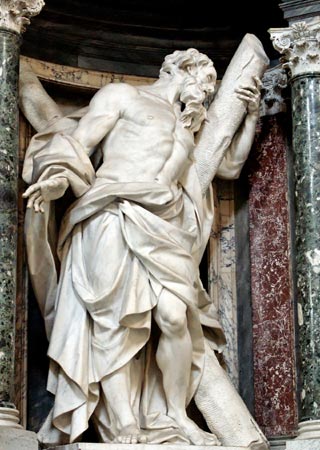The month of November marks an important day for Scots living both here in Scotland and those that reside elsewhere. Why? As this is the month when St Andrew’s Day is celebrated, honouring (as the name suggests), St Andrew, the patron saint of Scotland.
Although an instantly recognisable name the world over, the history of St Andrew may not be, so today, we are exploring the legends and stories behind this Scottish patron saint.
Saint Andrew’s Day Scotland
Before we go any further, we need to start with the date that Scots celebrate St Andrew’s Day – at the end of November, on the 30th to be exact.

This date is said to be significant for a couple of reasons. The first relates to the date St Andrew is said to have met his death on a Saltire, which is irreconcilably linked to Scotland via our flag (more on this later).
The second relates to an American group of USA-based Scots that wanted to pay homage to their homeland. This version states that a group set up in South Carolina in 1729 set the date of 30 November as a day to celebrate St Andrew, which is still recognised today.

Irrespective of the reason behind this specific date, 30 November is a day for celebration, often including food, drink and dancing (time to get your ceilidh on!) – a great day to visit Scotland! And if you happen to be in St Andrews, the celebrations continue for a whole week.
In 2007, the 30th was declared a public holiday by the Scottish Government, making it an even more special day for those who celebrate.
Story of St Andrew Scotland Patron Saint
Although we now recognise St Andrew as the patron saint of Scotland, it may surprise you to know that he wasn’t born here. Instead, around AD 5-10, St Andrew was born in Bethsaida and became an Apostle of Jesus. As a result, sometimes he is referred to as St Andrew the Apostle.
He travelled around preaching his message and has gone down in the history books as the one who brought Jesus the famed loaves and fish when “feeding the 5000”. As a result, St Andrew is closely linked to the religion of Christianity.
Death of St Andrews
During his many years as a missionary, Andrew converted countless people to Christianity. One of those who converted was the wife of the provincial Roman governor, who was not a supporter of the faith and ordered Andrew to be executed.
The Relics of St Andrew

As is befitting a saint, St Andrew remained infamous even after his death. The story varies depending on who you listen to/what you read, but all seem to agree that his relics made their way to Scotland in some form, establishing the Scottish connection that continues to this day.
Some stories state that the relics travelled from Greece to what is now Istanbul, then through to Italy before being partly returned to where he was to begin with, whereas others detail his bones being brought to Scotland, in what is now St Andrews.
The latter was said to be facilitated by St Regulus, who was compelled to transport the bones to Fife, where he built a chapel that would act as their final resting place. An alternative version suggests that St Andrew himself travelled to Fife in Scotland and built a church which was used for evangelism.
For those who know their history, if you’re thinking that the name St Regulus sounds familiar, that may be because of St Rule’s (St Regulus) Tower, still standing in the vicinity of St Andrews Cathedral to this very day.
St Andrew the patron saint of Scotland

The Declaration of Arbroath in 1320 was instrumental in St Andrew taking on his patron saint status. This declaration called for Scottish independence from Pope John XXII, and got its name from Arbroath Abbey, where it was signed.
A reproduction of the declaration can be found at Arbroath Abbey today, and in it, you may recognise a few famous names, such as Robert the Bruce. It states that St Andrew is the patron saint… and the legend begins (and continues to this day)!
However, St Andrew is not just the patron saint of Scotland. He also holds this title for several other places, including Greece and Russia, as well as for a range of groups such as fishermen, singers and even some health conditions, such as gout!
Despite his death all those years ago, it is clear that the legend of St Andrew is destined to live on for many years to come!
Saint Andrew Flag

We couldn’t mention St Andrew without going into a little more detail about the Scottish flag.
The white cross on a blue background is recognised as a Saltire, also known as a St Andrew’s Cross, and it is said the cross is symbolic of the death of St Andrew.
The flag is flown on certain special occasions, including Scottish-specific days such as the Declaration of Arbroath Day (6 April), Wallace Day (23 August) and St Andrew’s Day.
However, when it comes to buildings belonging to the Scottish Government, the flag is expected to be flown on such buildings every day.
Visit St Andrews with Scottish Tours
With St Andrew being the inspiration for the name behind the town found in Fife in the northeast of Scotland, its history is just one reason you should visit this golf-loving place!
A tour is the best way to ensure you don’t miss out on anything, and our St Andrews and the Kingdom of Fife tour combines the villages of Fife with the town of St Andrews itself. Or perhaps our St Andrews, Fife and Dunfermline Abbey with local pick-up tour will take your fancy instead? Here you will have the opportunity to take in many well-known landmarks, including the Forth Bridges and Dunfermline Abbey, before heading to the seaside town of St Andrews.
St Andrews is just one of the many attractions featured in our wide selection of Scottish Tours.
Book your Scotland Tour today.
Picture credits: Glasgow Life, Wikipedia and Shutterstock

